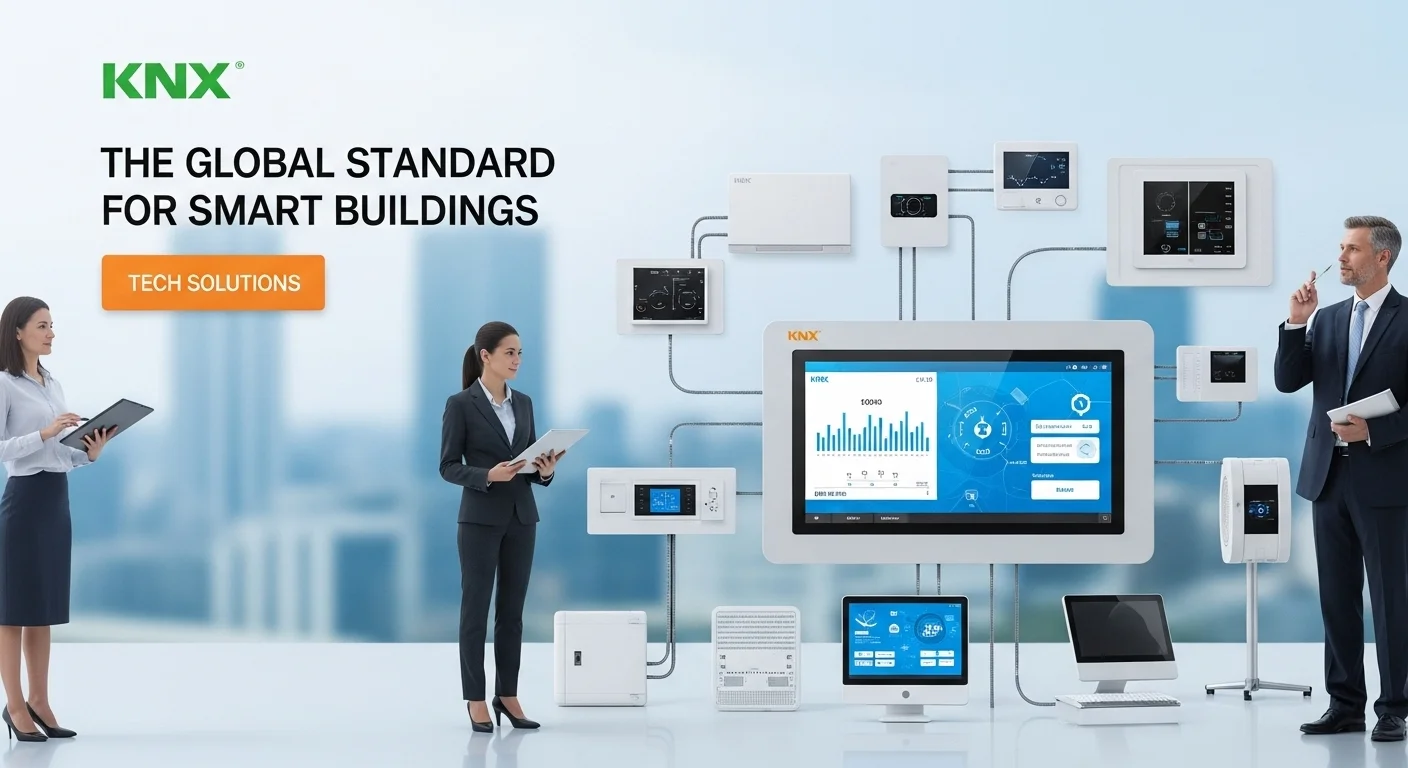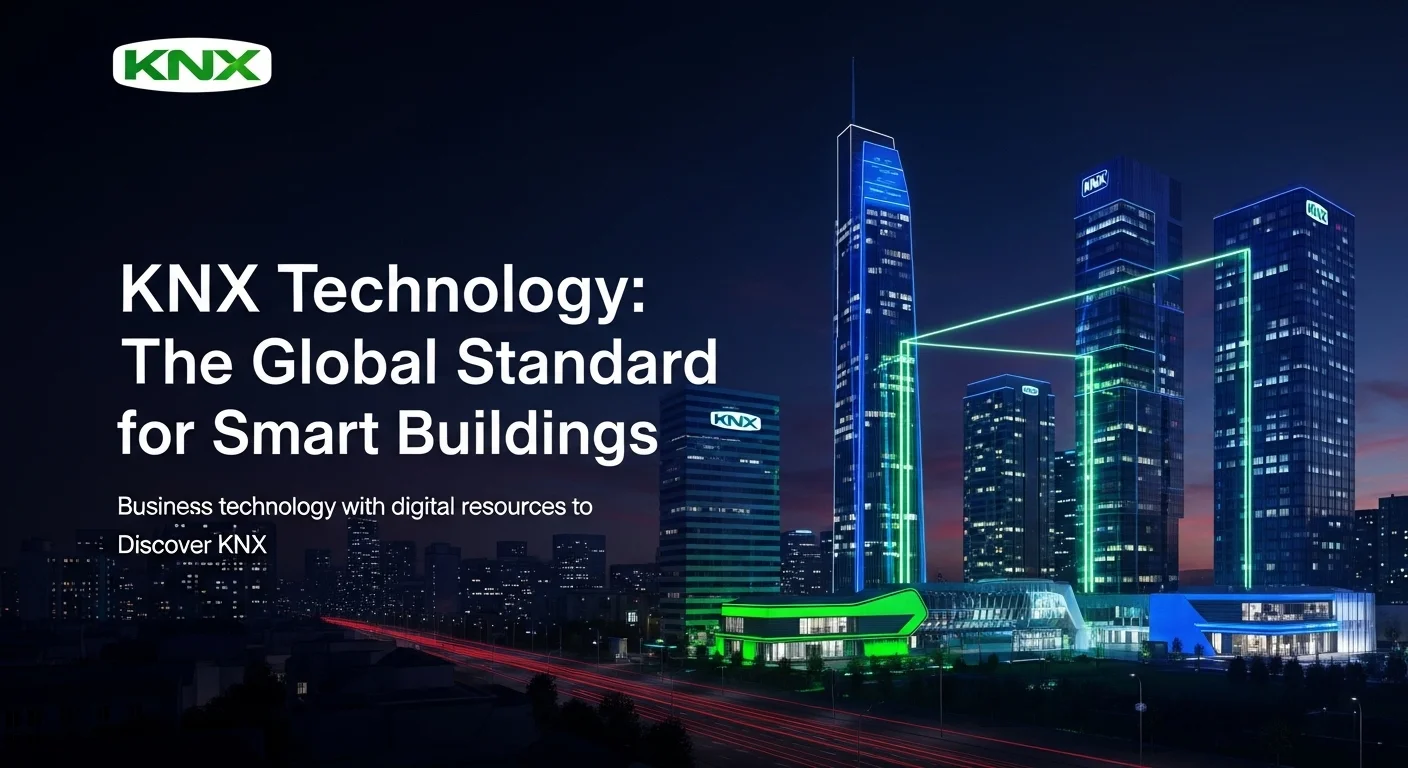KNX Explained: Your Ultimate Guide to the Smart Building Gold Standard

Executive Summary
When people ask me about creating a truly smart building, not just a home with a few smart gadgets, I always point them to KNX. For over 30 years, it's been the global standard (ISO/IEC 14543) for a reason. Think of it as the universal language that allows hundreds of different brands of devices to talk to each other perfectly. I've built my career on this robust, decentralized protocol because it delivers on its promises: unmatched reliability, scalability, and security. For businesses, this means creating intelligent buildings that slash energy costs and simplify management. For homeowners, it's about a seamless, sophisticated experience that just works. KNX is the professional-grade foundation for any serious automation project, designed to last for decades and adapt to future innovations like AI and IoT.
Table of Contents
What is KNX and Why is it the Professional's Choice?
In my years working in building automation, I've seen countless smart technologies come and go. But one standard has always been the bedrock of serious, professional installations: KNX. It’s the world's only open standard for both home and building control, the invisible nervous system inside thousands of intelligent buildings. Its real power, and the reason I trust it for my projects, is its ability to create a unified ecosystem. It allows devices from over 500 manufacturers to communicate flawlessly. This is a game-changer; it frees you from being locked into one brand and lets you pick the best device for the job, every time. KNX isn't a single product; it's a powerful communication protocol (standardized as ISO/IEC 14543-3). The magic lies in its decentralized design. Unlike many popular smart home systems that rely on a central hub, a KNX system has no single point of failure. I've seen systems where a central controller failing takes down every light and switch in the house. That doesn't happen with KNX. Each device on the network—be it a light switch, a sensor, or a heating actuator—has its own intelligence. If one device fails, the rest of the system carries on without a hitch. This reliability is non-negotiable in a commercial building and a huge source of peace of mind in a home. The physical backbone is typically that iconic green KNX cable, a twisted-pair bus line that runs alongside your standard electrical wiring. This dedicated, hard-wired network is incredibly stable and secure, immune to the Wi-Fi dropouts or interference that can plague wireless systems. But KNX is also incredibly flexible, supporting various media like Powerline (using existing electrical wires), Radio Frequency (for wireless needs), and IP/Ethernet for high-speed connections. This means I can design a solution for any building, whether it's a new build or a tricky historic renovation. In the bigger picture, KNX is a crucial enabler for the Internet of Things (IoT) in our buildings. It creates a standardized data highway, allowing thousands of devices to feed information into higher-level management systems. This data can be used by AI to optimize energy usage, predict when a system needs maintenance, and create spaces that truly adapt to the people inside them. For a business, a KNX smart building is simply a more efficient and cost-effective building. By integrating lighting, heating, and blinds, energy consumption can be drastically reduced. I've seen clients achieve massive savings just by using presence detectors to turn off lights in empty offices and daylight sensors to dim artificial lights when the sun is shining. These are core features of a well-designed KNX lighting control system. For homeowners, a home KNX system delivers a level of convenience and sophistication that feels like magic. A single 'Goodbye' button by the door can turn off every light, lower the blinds, set back the heating, and arm the security system. The user interface, often a sleek KNX lighting control panel or a smartphone app, brings all this control into one simple place. People often ask me about KNX vs. Z-Wave or other wireless protocols. While wireless systems are great for simple DIY projects, KNX is the choice for a professional, robust installation. The reliability of a wired system is simply unmatched. However, the KNX standard is smart enough to include KNX RF, which lets us create hybrid systems—marrying a rock-solid wired backbone with the flexibility of wireless devices where needed. It truly is the best of both worlds.

A Practical Guide to KNX for Business and Home
When you look under the hood of a KNX system, you find an architecture designed for incredible scale and long-term performance. It’s built on a hierarchy of lines and areas. A single line can host up to 256 devices, and you can connect multiple lines to form an area. You can then connect these areas to a backbone, allowing for enormous installations with tens of thousands of devices. This structure is smart because it keeps communication traffic local, ensuring the system remains fast and responsive no matter how large it gets. The heart of any installation is the Engineering Tool Software (ETS). This is the powerful, manufacturer-independent software I use to bring a project to life. With ETS, I design the entire system, configure every device, link sensors to actuators (e.g., 'when this motion sensor detects movement, turn on that light'), and diagnose any issues. The fact that ETS is a universal standard is a massive benefit for clients. It means any certified KNX partner can work on the system in the future, preventing you from being locked into a single installer. From a business standpoint, the return on investment for a KNX smart building is clear and compelling. The biggest driver is always energy efficiency. A well-implemented KNX lighting control system can slash lighting energy costs by as much as 60%. This comes from smart strategies like presence detection, constant light control that dims lights based on available daylight, and simple scheduling. When you add automated HVAC and blind control to the mix, the savings become truly significant, reducing both operational costs and a company's carbon footprint. In a residential home KNX system, the value is all about enhancing lifestyle through comfort, security, and convenience. The ability to create 'scenes' is where the magic really happens. A 'Movie Night' scene might dim the main lights to 10%, turn on soft accent lighting, lower the blackout blinds, and activate the AV system—all with a single tap. Security is also seamlessly integrated. If a window contact is triggered at night, the system can flash all the lights, raise the blinds to expose the interior, and send an alert directly to your phone. The KNX vs. Z-Wave conversation is one I have often. Protocols like Z-Wave and Zigbee are excellent for smaller, wireless-focused retrofits. However, for a new build or major renovation, the robustness of a wired KNX system is in a different league. Its reliability and security are why it’s the standard for critical commercial buildings. The KNX certification process is also far stricter, ensuring true, seamless interoperability between different brands, which can sometimes be a challenge with wireless ecosystems. But it's not a competition; it's about using the right tool for the job. Gateways allow us to bridge KNX and Z-Wave systems. I often design a 'hybrid' system for clients: we use KNX for the mission-critical backbone of the house, and then use a KNX Z-Wave gateway to integrate a specific smart lock or wireless sensor that might not have a native KNX version. The main point of interaction, the KNX lighting control panel, has evolved into a beautiful and powerful command center. Modern touch screens provide a graphical floorplan of your home, allowing you to control every light, curtain, and thermostat with ease. These panels can also display energy data, weather forecasts, and feeds from security cameras. The real work is done by actuators, typically mounted in the electrical panel, which take the commands from your panel or sensors and execute them—switching, dimming, or even changing the color temperature of your lights to match the time of day.

Expert Tips for a Flawless KNX Installation
Putting a KNX system into your property is a serious technology investment. To truly get the most out of it, planning and strategy are everything. Over the years, I've developed a set of best practices that I follow for every project, whether it's a large commercial KNX smart building or a high-end home KNX installation. The single most important piece of advice I can give is to future-proof your installation. A successful project starts with a detailed plan of what you need now and what you might want in five or ten years. The biggest mistake I see is people trying to save a little money by not running cable everywhere. The green KNX bus cable is relatively inexpensive. Run it to every room, every window, and even to places you don't think you'll need it yet. Having that cable in the wall is your ticket to easy, cost-effective expansion down the road. Trust me, you'll be glad it's there. My next non-negotiable is documentation. A well-organized and commented ETS project file is the blueprint of your system. It's invaluable for any future maintenance, troubleshooting, or upgrades. It means any certified professional can immediately understand how your system works. Speaking of which, always hire a certified KNX Partner. These are integrators who have passed rigorous training. Their expertise is what separates a clunky, frustrating system from one that is robust, intuitive, and a joy to use. As our buildings get smarter, they can also become targets. This is why we must talk about cybersecurity. The KNX Association has developed KNX Secure, which provides powerful end-to-end encryption. I insist on using KNX Secure-enabled devices, especially for any connection to your internet router and for security functions. It's just as important as having a good lock on your front door. You should also follow standard IT security hygiene, like using strong passwords and ensuring any remote access is done through a secure VPN. To elevate the experience in a home KNX system, we need to think beyond just turning things on and off. We create powerful scenes that automate daily life. A 'Welcome Home' scene, triggered by your phone's location, can light a path to the kitchen, set the temperature perfectly, and start your favorite playlist. We can even implement Human-Centric Lighting using your KNX lighting control system. This uses special tunable white lights to subtly change color temperature throughout the day, mimicking the natural rhythm of the sun, which can improve well-being and productivity. On the topic of KNX vs. Z-Wave, think of it as strategic integration. A KNX-to-Z-Wave gateway is a fantastic problem-solver. If you fall in love with a specific smart lock that only speaks Z-Wave, no problem. The gateway allows us to bring it into the main KNX system so it can be part of your security scenes. This hybrid approach gives you the reliability of a wired core with the flexibility to incorporate the vast world of wireless gadgets. In summary, getting the most from KNX comes down to smart planning, hiring a pro, focusing on security, and being creative with automation. By planning for the future and designing intelligent scenes, you can transform your property into a truly smart, efficient, and delightful environment to live or work in.
Expert Reviews & Testimonials
Sarah Johnson, Business Owner ⭐⭐⭐
As a business owner, I found the information on KNX accurate. I just wish there were a few more real-world case studies for businesses like mine.
Mike Chen, IT Consultant ⭐⭐⭐⭐
A solid overview of KNX. It definitely cleared up some things for me, though a couple of the technical explanations could be simplified a bit more for newcomers.
Emma Davis, Tech Expert ⭐⭐⭐⭐⭐
Fantastic article! As a tech professional specializing in this area, I found it incredibly comprehensive and clear. It's a great resource that helped me connect all the dots perfectly.



